Youtiao (油条) is a hugely popular Chinese street food, a deep-fried breadstick crispy outside with a spongy interior. It is commonly served with soybean milk or porridge and has a universal appeal to everyone regardless of race and origin.
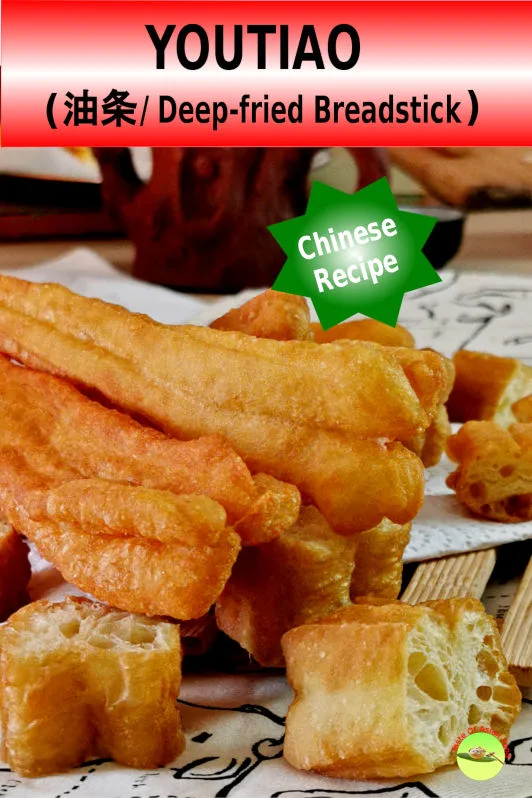
Youtiao is sold everywhere down the street, wherever there is a large Chinese population. If you want to make it yourself, here is the step-by-step instruction that will guide you through how to make youtiao.
Since this is a long article, I have divided it into four sections. You can click the link below, which will bring you to the respective section.
- The instruction on how to make youtiao
- Tips on making the best youtiao
- The test and the conclusion that I carried out while formulating the youtiao recipe
- The folklore of youtiao
- The youtiao recipe
Note: Youtiao has different names in Chinese and English. The following phrases are all referred to as youtiao: Chinese donut, Chinese fried dough, Chinese crullers, 油炸桧, 油条, 油炸鬼.
1. The instruction on how to make youtiao at home
Please watch the video in this article that shows you clearly how to make youtiao.
Part one: Preparing the dough
- Mix the flour, baking powder, active dry yeast, salt, eggs, and water in a large mixing bowl with a pair of chopsticks or silicone spatula to form a sticky dough. You can also dissolve the yeast in the water first. I have tried both ways, and there is no difference in the outcome.
- If you are unsure about the actual amount of water required, do not use all but reserve about ten percent. You can add the remaining if you find that it is too dry.
- Cover and let it rest for 20 minutes.
- After 20 minutes, the dough has become more relaxed and easy to knead.
- Measure the vegetable oil required in a separate dish. Dip your fist into the vegetable oil, then press and twist your fist lightly to incorporate it into the dough. The oil helps to prevent the dough from sticking on to your hand.
- Continue adding the vegetable oil until all is absorbed into the dough. The dough should now become smoother and less sticky.
- Cover it and set aside for forty minutes to let the yeast hydrolyze the sugar, produce air, and create the flavorful components.
Part two: Shaping the dough
a) Portion the dough
- After forty minutes, the dough has become very relaxed and easy to stretch, and with some air trapped inside due to the yeast’s activity.
- There is no need to knead the dough further at this stage. Place it gently on a floured surface (I use a pastry mat) and pull it gently to form a long rectangle. Remember to flour the surface often so that the dough will not stick to it.
- Use a rolling pin to roll out the dough. The thickness should be about half a centimeter (about 1/4 inch) thick and about 8 centimeters (3 inches) on the short side of the dough.
- Straighten the sides to form a rectangle by using the dough cutter.
- Sprinkle some flour on the surface to keep it dry. This step is crucial because we will stack two doughs together later, and the flour will prevent them from sticking together.
- Cut off both ends of the dough and then divide the remaining into 2.5cm (one inch) wide strips. Now we have many strips of dough measuring 8cm x 2.5cm x 0.5 cm.
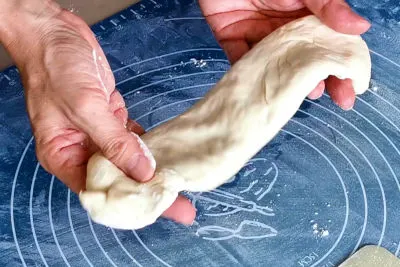
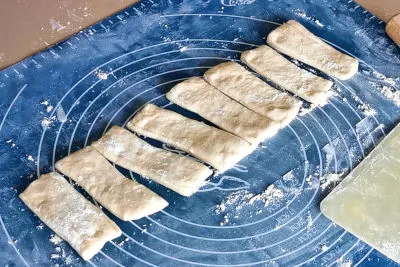
b) Shaping and pulling the dough
- Arrange the dough pieces in a row, with wide gaps in between.
- Sprinkle some flour to the gaps, and apply the flour to the dough pieces, especially the sides.
- Dip a chopstick into a glass of water, and press it right at the center, parallel to the dough’s longer side.
- This step aims to wet the middle line of the dough while keeping other parts dry.
- Next, place a piece of dry dough on top of the first (wet) dough.
- Use a dry chopstick or a thin skewer to press the center again. The top dough will stick to the bottom dough where the water is applied and still detach on the dry surface. This step is vital to make youtiao expand fully in all directions during deep-frying.
- Let it rest for five minutes to relax the dough.
- Stretch it gently by holding both ends. You can pull a relaxed dough to about 2.5x of its original length. Since the dough’s length is 8cm, I can pull it up to 20cm without breaking it.
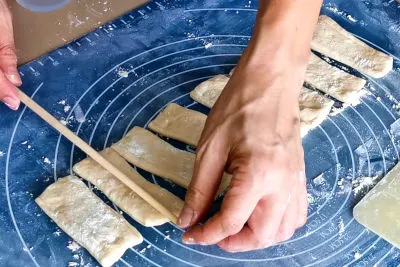
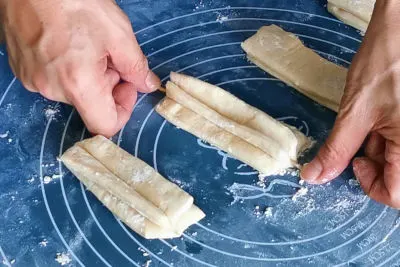
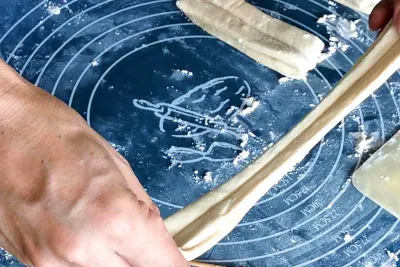
Part three: Deep-fried the youtiao
- Heat a large pot of oil either using a wok, an electric deep-fryer, or a large pot.
- You need to deep-fry the youtiao in hot oil to make it fully expanded, with large hollow spaces inside. This structure can only be achieved if the oil is at about 200°C/390°F. You can use a kitchen thermometer to measure the temperature before frying. An easy way to achieve the right temperature is to throw a piece of small dough into the oil. If the dough sinks and is surrounded with bubbles initially, then expands and floats to the top quickly within three to five seconds, the temperature is now suitable to fry the youtiao.
- Dip the center portion of the stretched youtiao into the oil for half a second, then gently lower the whole youtiao into the oil.
- The youtiao will expand rapidly and float to the surface within three to five seconds. After that, keep turning it every few seconds to deep-fry it uniformly. If not, the portion exposed to air will cool down quickly and be unable to expand fully.
- After the first thirty seconds, the fully inflated youtiao has become a firm and hollow structure. From now on, flip it over every half a minute. Deep-fry each youtiao for about two minutes, or until the youtiao becomes golden.
- Remove and drain on a paper towel to remove the excess oil.
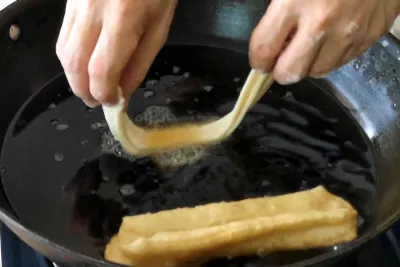
Please refer to this section if you have doubts when following the abbreviated instruction in the recipe below. It is also helpful to watch the video on this page, which demonstrates to you how to make it step-by-step,
The following section is a collection of my tips on how to make the best youtiao. Please read it before attempting this recipe, especially if you are new to youtiao making.
2. Tips on how to make the best youtiao
Based on the test result and what I learn throughout the experiment (in the next section), the following are the tips to achieve the best result.
a) Why do I use baking powder and yeast in the recipe?
I expect some youtiao makers will wonder why I use baking powder and yeast in the recipe. Isn’t it sufficient to use either one of them? The answer is yes, but it may not be perfect.
- I use yeast to improve the flavor. Yeast produces enzymes and other flavorful components during the fermentation process. These flavorful components significantly enhance the taste of youtiao. It is validated by the comparison of taste between formula A and D. (see section 3 below.)
- I only use 2g of baking powder for every 100g of flour. Any amount more than 2g will leave an aftertaste and a slight tingling feeling on the tongue since I have sensitive taste buds and want to eliminate it by using less baking powder. The yeast that I have added offers the leavening effect needed to make a fully expanded youtiao.
- Youtiao prepared with yeast alone is not as fluffy as those with baking powder.
- With the presence of baking powder and yeast, baking soda is no longer necessary. After all, baking soda will leave a slightly bitter taste, which is not desirable.
b) Is Baking soda required to darken the color of youtiao?
Some recipes use baking soda to darken the color of the youtiao. Baking soda is alkaline and has the effect of lowering the caramelization point of sugar, thus darkening the color. However, the color also depends on the temperature and duration. Deep-frying at 200°C can achieve a golden color in two minutes since the typical caramelization point is at 170°C.
c) Do not flip the youtiao too often after deep-frying for half a minute. Why?
- The youtiao expands quickly in the first five seconds, creating hollow spaces inside and, therefore, float to the surface. You can push it lightly with the chopsticks to correct its shape during this stage if required. You cannot change its shape anymore once it becomes fully expanded and firm.
- The part that is floated above the surface must be turned around repeatedly so that it will expand uniformly. This step is simple but is critical to the success of making youtiao.
- Flip the youtiao at a 30 seconds interval once it has firmed up. Once you flip over the youtiao, the area touching the oil is now floated on top and cools rapidly. When you flip it for the second time after half a minute, the cooled area will be submerged in the oil and deep-fried for the second time. This process mimics the double deep-fried method to make potato chips crispy on the outside and soft inside. Youtiao made this way will remain crisp for a much longer duration, even up to an hour.
d) What is the best temperature to deep-fry the youtiao?
The temperature for deep frying is one of the most critical elements to ensure youtiao’s success. Make sure the temperature is hot enough before you dip the youtiao into the oil. Otherwise, the youtiao will not fully expand.
You can check the oil’s temperature by throwing a small piece of the dough into the oil. The ideal temperature is when the dough floats on the surface within 3 to 5 seconds. If you dip the youtiao dough into the oil at this temperature, the dough will suspend in the oil initially and float to the surface within seconds.
e) Can I use bread flour to make youtiao?
I use all-purpose flour in this recipe, which has 9% of protein. Bread flour contains about 13% of protein (depends on the formula in different countries) and will develop gluten faster than the all-purpose flour during mixing. I have compared both (Formula A vs. C in the next section), and the difference in taste and texture is not noticeable. However, the dough made with bread flour is less stretchy and challenging to pull it to form a long, lean youtiao.
If you are using any flour with more than 12% of protein, you can add a little more oil or substitute part of it with low protein flour.
f) Should I use eggs and milk in the youtiao recipe?
Eggs improve the flavor and color of youtiao. However, too much egg will cause the youtiao to become less crispy. You can also enhance the flavor by substituting part of the water with milk.
g) Can I reduce the amount of water if my dough is too wet?
The actual amount of water required depends on the flour. The total amount of water plus eggs in this recipe is 70% of the flour’s weight. You may need to use less than if you find that the dough is too sticky. It can range from 60% to 70%. If the dough is too sticky, add a small amount of flour while mixing until it is manageable.
The dough will become less stretchy if it contains too little water.
h) Is Ammonium bicarbonate used as a leavening agent in making youtiao?
Traditionally, a leavening agent called ammonium bicarbonate (commonly known as 臭粉 in Chinese ) is used to make youtiao. It creates a lighter or crispier texture than can be achieved by using baking powder or soda. Although it is generally recognized as safe (GRAS) by the American Food and Drug Administration (FDA), it has become hugely unpopular and is only available at some large baking suppliers.
The most commonly used leavening agents currently used are baking soda, baking powder, and yeast.
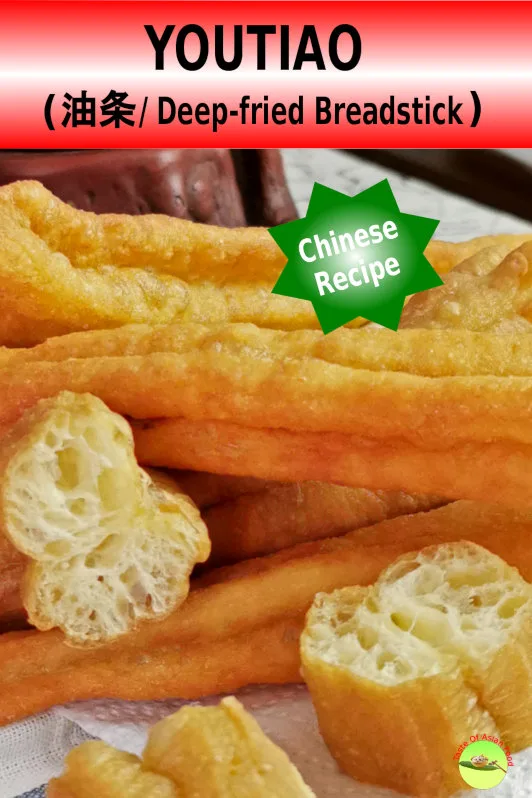
3. The tests that I carried out while formulating the youtiao recipe
There are many different recipes for youtiao. Each of them has merit, but it also becomes confusing when deciding which formula is best for me.
Curious to know the answer, I carried out some tests to determine the appearance, texture, and taste of youtiao preparing according to various recipes.
Here is the comparison chart of the different formulas that I have tested.
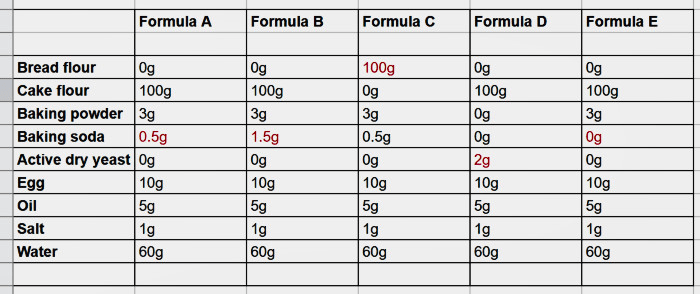
Here is a summary of the result.
Formula A vs. B (B has a higher amount of baking soda)
Youtiao prepared by using both methods has a reasonable volume. However, there is an unwanted aftertaste, which is quite noticeable for Formula B. This bitter taste is due to the higher quality of baking soda.
The additional amount of baking soda (0.5% for A, 1.5% for B) does not further increase the size. Therefore, 0.5% of baking soda is sufficient to make youtiao.
Formula A vs. C (C use higher protein flour)
The only difference between A and C is the types of flour used. Both formulas’ texture and taste are identical, and there is no noticeable difference when doing a taste test. I will stick to the all-purpose flour. It has a lower protein content, and therefore less gluten is formed during the kneading process. As a result, it is more stretchable and easier to work with.
Formula A vs. D (D is a yeast formula)
The color of A is much darker than D. I have fried D longer, but the color is still much lighter than desired. Baking soda and baking powder are required to darken the color. Formula D involves using only yeast as the leavening agent.
Formula A vs. E (E has no baking soda)
The color and size are the same for A and E. The color is darker than D, which indicates baking powder can somehow darken the youtiao’s color. The unwanted taste in D is no longer there, which is a much-needed improvement. Baking soda can be removed from the formula.
I formulated a new formula with yeast and baking powder, without baking soda based on the above result,
Other related recipe to youtiao
If you like youtiao, you may also like to know how to make two closely related Dim Sum recipes: Cantonese porridge and Cheung Fun (rice noodle rolls).
Cantonese style porridge is a popular item served at the dim sum store. The youtiao is served by cutting into short sections and dip into the porridge to soften it before eating. As for Cheung Fun, it is on the menu of every Dim Sum restaurant.
4. The folklore of youtiao
The name of youtiao is derived from You Char Kuai 油炸桧, which means deep-fried Kuai. Legend has it the corrupted Prime Minister Qin Kuai 秦桧 and his wife of the Southern Song Dynasty of China were envious of the loyal general, YueFei 岳飞, They planned an evil scheme to frame Yue Fei and murdered him. When people learned the news that Yue Fei’s having been murdered, they were filled with anger.
Two street food vendors devised a way to express their views. One of them sculpted miniatures of Qin Kuai and his wife out of dough. The other conveyed his rage by twisting two doughs representing Qin Kuai and his wife and threw it into the wok. He yelled out loud that Kuai is deep-fried.
Hence, people called this deep-fried dough as You Char Kuai, which means ‘deep-fried ‘Kuai.’ The word ‘Char Kuai’ is now replaced by most people with the world Tiao 条, which means a strip of dough. YouTiao 油条 has now become the most common name of this Chinese street food.
5. The Youtiao recipe

How to make Youtiao
Youtiao (油条) is a hugely popular Chinese street food, a deep-fried breadstick crispy outside with a spongy interior.
Ingredients
- 200g all-purpose flour
- 4g baking powder
- 2g active dry yeast
- 2g salt
- 20g egg
- 120ml water
- 20g vegetable oil
Instructions
Prepare the dough:
- Mix the flour, baking powder, active dry yeast, salt, egg, and water in a large bowl to become a sticky mass. Cover and let it rest for 20 minutes.
- Add the vegetable oil to the dough by rubbing in with your hand. The dough should now become smoother and less sticky.
- Cover the dough and set aside for forty minutes.
Shape the dough:
- Place it gently on a floured surface. Roll out the dough until to and cut into small strips measuring 8cm x 2.5cm x 0.5 cm.
- Apply the flour to the dough pieces to prevent it from sticking.
- Dip a chopstick into the water, and press it right at the center, parallel to the dough’s longer
- Next, place another piece of dry dough on top of the first (wet) dough.
- Use a thin skewer to press the center again to let the second dough stick to the first dough where the water is applied.
Deep-fried the youtiao:
- Stretch each dough gently to about 2.5x of its original length.
- Dip the center portion of the stretched youtiao into the oil (200°C/390°F) for half a second, then gently lower the whole youtiao into the oil to deep-fry.
- Keep turning it every few seconds to deep-fried it uniformly for the first 30 seconds.
- From now on, flip it over only every half a minute until the youtiao becomes golden.
- Remove and drain on a paper towel to remove the excess oil.
Recommended Products
As an Amazon Associate and member of other affiliate programs, I earn from qualifying purchases.
-
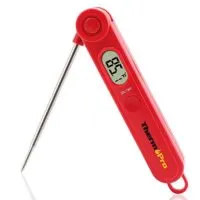 ThermoPro TP03A Digital Instant Read Meat Thermometer Kitchen Cooking Food Candy Thermometer for Oil Deep Fry BBQ Grill Smoker Thermometer
ThermoPro TP03A Digital Instant Read Meat Thermometer Kitchen Cooking Food Candy Thermometer for Oil Deep Fry BBQ Grill Smoker Thermometer -
Secura Stainless Steel Deep Fryer with Basket, 3.2 Quart
-
 Rolling Pin & Silicon Pastry Mat,Silicone Large Pastry Mat With 19.6" x 15.7",Dough Roller Sleek and Sturdy 11.8" Perfect Match
Rolling Pin & Silicon Pastry Mat,Silicone Large Pastry Mat With 19.6" x 15.7",Dough Roller Sleek and Sturdy 11.8" Perfect Match -
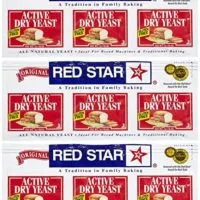 Red Star GlutenFree Active Dry Yeast, 0.75 oz, 3 ct, 3 pk
Red Star GlutenFree Active Dry Yeast, 0.75 oz, 3 ct, 3 pk
Nutrition Information:
Yield: 8 Serving Size: 1Amount Per Serving: Calories: 118Total Fat: 3gSaturated Fat: 0gTrans Fat: 0gUnsaturated Fat: 2gCholesterol: 9mgSodium: 181mgCarbohydrates: 19gFiber: 1gSugar: 0gProtein: 3g
This data was provided and calculated by Nutritionix on 10/16/2020

Amelia
Monday 26th of August 2024
These fritters are simple to make and surprisingly flavorful, just the kind of classic flavor I've been craving and my whole family loves them! https://www.cookcoda.com/chinese-doughnut-sticks-youtiao/ I found another fritter recipe today, is this authentic please?
KP Kwan
Monday 26th of August 2024
I would say it is authentic. My recipe is a little different from the one you provided, and the reasons are mentioned in my post. I hope you enjoy the Youtiao, no matter which recipe you follow :)
WHleong
Wednesday 21st of June 2023
Can egg be omitted replace with water or milk.
Notice hawker do not use egg to make you tiao.
KP Kwan
Thursday 22nd of June 2023
Eggs improve the flavor and color of youtiao. You can replace it with milk.
Yasmin Ling
Sunday 30th of October 2022
Hi. Thank you for such a thorough instruction and explanation. May I know if it’s possible to frozen the youtiau, just like how we can do with doughnuts (e.g. give them a quick deep fry)?
KP Kwan
Friday 4th of November 2022
You can freeze the raw dough of the Youtiao.
Chai
Saturday 11th of June 2022
Hi! Thank you for your experiments and recipe :) I noticed your recipe wrote 6g of baking powder, but in the explanations, you said you use 2g per 100g of flour. The video also wrote 4g of baking powder used. I supposed 4g is the correct amount? Thanks for clarification
KP Kwan
Sunday 12th of June 2022
Hi Chai, Thank you for pointing out the error. You are correct. I used 4g, not 6g, and have corrected it in the recipe. Thanks again. KP Kwan
Jessica
Sunday 27th of March 2022
I tried it and worked better than any other recipe I’ve used! In the past, I’ve used baking powder with a cold rise method and didn’t achieve that interior with all the air bubbles and it just came out more bread-like. I suspect it’s because the cold fridge can never fully proof the dough. Using yeast worked wonders as the proofing time allowed it to double in volume and made the bubble interior just as I was hoping for. I also put it in the oven on the lowest setting (150 f) to help it proof faster. One thing I noted was that it had more bubbles when the dough was rolled out a bit thinner and not as thick.